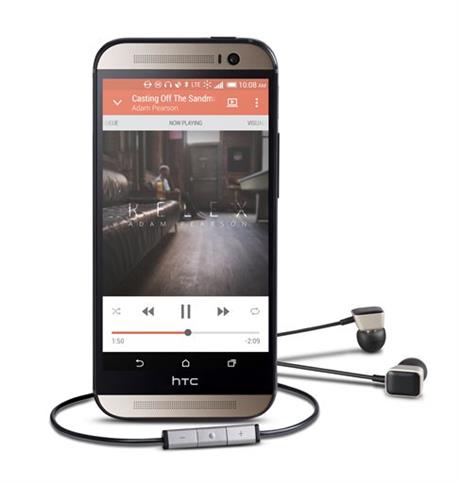LOS ANGELES (AP) — Bring back the equalizers!
That’s my conclusion after trying out Clari-Fi, a new technology from audio equipment maker Harman Kardon. Clari-Fi aims to restore some of the audio signal that is lost because of digital compression in today’s download and streaming formats.

However, based on some testing, I’m not sure what exactly it does.
My best guess is that it kind of boosts the treble, those high-pitched sounds that can sound tinny if overdone.
But unlike the stereo receivers of decades past, it doesn’t allow you to dial in a little at a time. There’s only one choice: on or off.
Clari-Fi comes with a special Harman Kardon edition of the HTC One M8 smartphone, one that is available in the U.S. only through Sprint.
This phone also has a feature called LiveStage, which claims to tune your listening experience to the specific Harman Kardon earphones you are wearing. Once again, your choice is limited to on or off, and you have to select which earphones you have.
My testing consisted mostly of streaming Lily Allen’s “Sheezus” album and Mumford & Sons’ “Babel” over Spotify on Wi-Fi using the HTC One M8, Nokia’s Lumia 1520, Apple’s iPhone 5 and a computer.
I found that LiveStage basically tamps down and smooths out the sound, while Clari-Fi sharpens it back up again. Slightly.
That said, I experienced way bigger differences in sound by switching earphones.
The AE-S Premium set, which comes with the HTC phone, produced the highest treble sound of the three I was using. The most neutral was a set of earphones that came, incredibly, from a BlackBerry that I no longer use. A third set whose brand name I forget was heaviest on the bass, reminiscent of the Beats by Dre brand, which Apple is in the process of buying.
Mixing the different earphones with LiveStage and Clari-Fi on or off produced a range of results.
Having Clari-Fi and LiveStage on with the AE-S produced, for me, an unacceptable amount of tinny sound. Mumford & Sons’ banjo went from twangy to screechy, while Allen’s voice sounded way too whispery.
The bass-heavy earphones overpowered the impact of toggling almost completely.
With the neutral headphones, I preferred Clari-Fi and LiveStage off.
These tests made me wonder why consumers should have to subject their sound preferences to the whims of headphone manufacturers and technologists.
It’s not economical — or a good use of time — for everyone to have to test out multiple sets of headphones with different settings. These are blunt tools to attune sound to sensitive ears.
So, I searched the Google Play app store and found just the cure: a free Android app called “Equalizer” by Smart Android Apps LLC. Using five slider controls that represent different frequencies, I could adjust the music that was streaming from Spotify just fine. I could tweak the sound for different genres, albums, songs and artists as the music was playing. Finding the right mix was far more satisfying than any result I got during the test.
A similar search on Apple’s App Store produced a series of free and paid apps. Although the free ones — like Equalizer+ and Equalizer — seem to work only with songs downloaded to the iPhone, ones costing a few dollars work with streaming services, too. The $1.99 Denon Audio works with TuneIn, while SpotEQ, for $2.99, works with Spotify.
SpotEQ allows me to create a kind of curvy line with seemingly infinite adjustment possibilities. My preferred equalizer shape looks like a curvy “M,” which produces rich vocals and just the right amount of crispness. Not bad for not having to spend hundreds of dollars on a new phone.
My advice: don’t worry too much about what various equipment makers purport to do to your sound. Get a neutral set of headphones and use an equalizer app to take back control.
___
Follow Ryan Nakashima on Twitter at https://twitter.com/rnakashi





